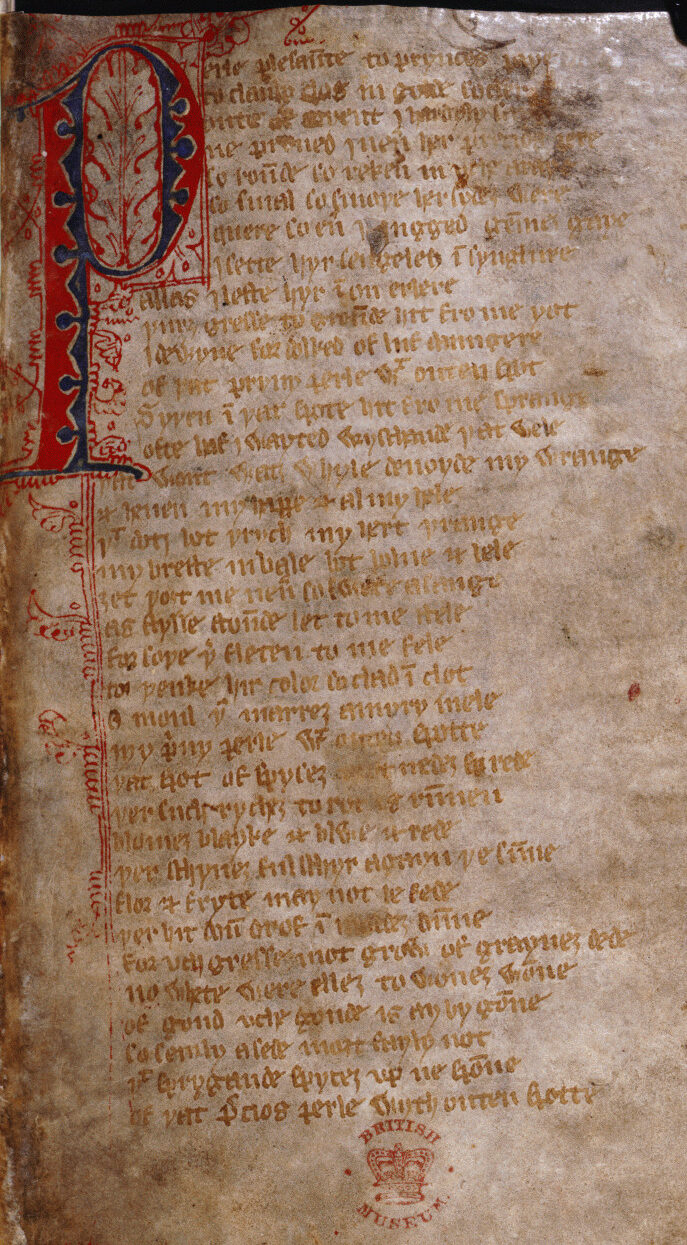The West Midlands Poet
14th century
(A father struggles to recover faith and peace after losing his baby daughter.)

Diversity of structure is one of the wonders of poetry. Today’s poets often celebrate freedom from structure, which has its own beauty. The medieval mind cherished a different kind of beauty, one that is neither extinct nor obsolete today, just overlooked. It is the elegant euphony of placing what one wishes to convey into a strict, unifying framework. Rather than delivering a point casually or even haphazardly as we may do in everyday life, the medieval poet would conform ideas to a predetermined scheme of alliteration, rhyme, stress, mid-line breaks (caesurae), and a multilevel organization of lines into stanzas and groups of stanzas, interconnected by strands of repetition. Surely it is a handicap to expression—but this is part of its charm! The skill required to create a meaningful poem that has a detailed or complicated structure is so great that its demands separate the geniuses from the dabblers. Modern poetic sensibilities may balk at this comment, but in this age where much art and poetry is still very polarized into distinct “high” and “low” forms, I think these sensibilities are a little hypocritical. It seems in fashion today both to create art that only a fraction of society can understand, and at the same time to repudiate notions of hierarchy, including hierarchy of understanding, wherever they appear. Generally the medieval mind, cultivated within the feudal economic and political system and a strongly hierarchical Church, was more candid about social stratification. Medievals did not tend to preach egalitarianism except under God, which would be realized only in another world. This perspective characterized their art as well as society. The structured medieval poem’s handicap to expression is in itself, aside from its resulting euphony or atmosphere, a badge of excellence.
 I do not think this effect is the primary one, however, when we read a poem as structured as Pearl. To see the medieval poets’ adherence to a strict form as primarily a show of technical skill is to slight them. Likewise it would be ridiculous to suggest that they were so ignorant or blinkered that they could conceive of no other form for poetry. Rather, I think they did it because of what they could gain aesthetically. Rigidity of structure creates a monument out of an idea. Read aloud or hear Pearl read in its original early English, and you will receive an incomparable effect of permanence, of immortality, of the poem having always existed, its story and message timeless and unwavering. What better atmosphere, for a poem whose central theme is transcendence over doubt and the ephemeral earthly life, to a focus on higher things that never change (God and a loving plan for the universe)! So I do not think it a coincidence that the medieval poem in general is known both for its eternal themes and for its rigid structure. The structure intensifies the theme, and is a prime vehicle for it, much as stone is an appropriate substrate for a statement one wishes to sculpt for everyone, for all time.
I do not think this effect is the primary one, however, when we read a poem as structured as Pearl. To see the medieval poets’ adherence to a strict form as primarily a show of technical skill is to slight them. Likewise it would be ridiculous to suggest that they were so ignorant or blinkered that they could conceive of no other form for poetry. Rather, I think they did it because of what they could gain aesthetically. Rigidity of structure creates a monument out of an idea. Read aloud or hear Pearl read in its original early English, and you will receive an incomparable effect of permanence, of immortality, of the poem having always existed, its story and message timeless and unwavering. What better atmosphere, for a poem whose central theme is transcendence over doubt and the ephemeral earthly life, to a focus on higher things that never change (God and a loving plan for the universe)! So I do not think it a coincidence that the medieval poem in general is known both for its eternal themes and for its rigid structure. The structure intensifies the theme, and is a prime vehicle for it, much as stone is an appropriate substrate for a statement one wishes to sculpt for everyone, for all time.
Despite the Pearl author’s apparent attempt to revitalize the art of medieval poetic structure, this revival failed to continue after him. I would hazard the simple explanation that much of fifteenth and sixteenth century English culture was moving away from that medieval mindset I described above, into an early modern one. As J. R. R. Tolkien (and surely others) noted, it is Chaucer’s more carefree poetic spirit, and his more urbane London language, that would live on in subsequent English literature, rather than the style or wording of Pearl. The difficulty of the language of Pearl as compared to Chaucer’s poetry is surprising. One can find editions of Pearl in the original language and struggle through with the aid of notes, and this can be enjoyable for some; but for an easy read, a translation is essential.
The West Midlands Poet is the supreme example of a dropped thread in the history of literature. His identity is unknown. Tolkien said of this, “…he was a major poet of his day; and it is a solemn thought that his name is now forgotten, a reminder of the great gaps of ignorance over which we now weave the thin webs of our literary history.” Speaking of Tolkien, I would heartily recommend his translation of Pearl and related poems. He is true to the spirit of the West Midlands Poet, and true to the meter and structure of the poem. He is a great author in his own right, who identifies very much with the kind of inspiration– mythic yet personal, reverent yet intellectually demanding– that would have driven the West Midlands Poet.
Concentrating too much on structure, form, and even the historical place of Pearl misses the point of the poem, however. This piece, like any great work, is as rewarding for its substance as for its form. In fact the author would almost certainly have considered its substance more important, its form intended to be in its service. Pearl, though an old poem and in a long-undervalued tradition, springs from a core element of humanity that is equally relevant in any age or culture. The struggles of someone in serious mourning, indeed of anyone who has reasons emotional or rational for challenging orthodoxy, is of remarkable and timeless value. Some questions the narrator raises are parochial and perhaps not very interesting to most of us; but other issues will always speak to a reader. And, stepping back from the particulars, thoughtful members of any society will identify with the general act of throwing one’s hands up in exasperation at God or the universe and demanding an explanation—whether this is perceived as blasphemous, bold, or simply an honest upwelling of the human spirit.
SUMMARY (Each Roman numeral refers to a section of five 12-line stanzas)
A man who has recently lost his young daughter wanders in mourning through the garden where she is buried (I). He sees a vision of an enchanted land beyond a stream (II), where he notices a young woman dressed in white who must be his Pearl (III-V). They speak to each other, and she tells him that he is wrong to think her vanished, for she is in fact in bliss, a queen of Heaven, wed to God (VI-VIII). She scolds him for not having faith in the Resurrection. This begins an interchange on the nature and logic of sin, salvation, and Paradise (VIII-XVI). The narrator accepts the rebuke for his lack of faith, but cannot understand how Pearl, so young, could possibly be accepted by God as his queen. She explains that all women are queens, just as all men are kings, in Paradise. Although the experience of each individual is different, each is appropriate to the person, everyone is perfectly blissful, and there is no envy. In response to his suggestion that she was too young to deserve this exaltation, she corrects him in two ways. First, she reminds him that nobody in fact deserves Paradise, and tells him the biblical Parable of the Vineyard. Equal wages were given to all who were brought into the vineyard to work, even though some people were brought in just an hour before the end of the day. In the same way, God’s mercies to those baptized into his Vineyard transcend the temporal. Secondly, she explains that infants are no less justified than adults, for there are two ways in which we may be justified and made worthy of a heavenly reward. The innocent are saved by right—but since we all sin, the only people that fall into this category are the very young, whose sin inherited from Adam is washed away by baptism. The rest of us are saved by righteousness—by Jesus’ payment of the price for our sins by dying on the cross. She reviews for him the Apocalypse of St. John, which describes the nature of Paradise. The narrator is fascinated and asks her if he might see this New Jerusalem. She tells him to follow the river, and when he does, he is able to see the radiant city, of transparent walls decked with various gems (XVII-XVIII). He sees a procession of maidens like Pearl, all parading towards the throne of God (XIX). The poet is struck by a longing to be in that place. As he tries to cross the stream, he awakens, lying in the garden. He is no longer anguished, but accepts his dismal existence on earth without his Pearl, in order to please his God who has planned everything for eternal good (XX).
Gleanings
- Here are three examples of lines of wonderful but untranslatable alliteration:
- Line 166: “So schon that schene ununder shore” (Tolkien’s translation: “She shone in beauty upon the shore”)
- Line 320: “Thy corse in clot mot calder keve.” (Tolkien: “Your flesh shall in clay find colder lair”)
- Line 346: “Braundysch and bray thy brathes breme,” (Tolkien: “Rampant bray and raging scream”)
- II: Picture of a marvelous and enchanting forest, including beautiful birds with music beyond human ability to reproduce; the poet elaborates on the wonderment of the forest, describing the stream and bed as gems.
- Lines 125ff: the experience of joy through nature.
- Lines 170ff: the ‘pain’ of observing feminine beauty.
- V: A response to grief—don’t be mad at fate (God), for what you have lost had been given to you, who had nothing before.
- VI: [A stoic sentiment:] why bother crying about life’s vicissitudes—it won’t change a thing; you must take what God dishes out. The practical solution for grief or suffering is not to rebel, but on the contrary to get close to God.
- VIII, XV: [As in Dante’s Paradiso,] various honors are bestowed in heaven, but there is neither usurpation or envy, but harmony as among body parts.
- XI: Pearl’s reply to the poet’s challenge about just rewards: no one deserves heaven; we all must rely on God’s grace.
- XI: Summary of the Christian story of Creation, Fall, and Redemption.
- XII: Exposition of 2 routes to salvation: right (innocence) and righteousness (atonement).
- XIII: Heaven, brideship with God, considered a Pearl. [So, in this section, stanza 3, there are three pearls considered together: the maid, her ornament, and Paradise—a marvelous poetic device.]
- XIV: An account of the Crucifixion.
- XVIII: Interesting concept: everything is transparent in heaven (symbolic).
- XIX: God is portrayed in a manner enviable for human males: all the virgins follow him and are mild and beautiful; and all the most respected men fall on their knees in obeisance. [Don’t let it be said that only Islamic literature portrays God and Paradise as grotesquely masculine.]
- XIX: God is portrayed as eternally wounded [a common idea in some Christian circles, which solves some theological problems, but creates others…].
Tidbits of Significance
(Pearl is composed of 20 groups of five 12-line stanzas, to which one stanza was added for a total of 1212 lines. Numbers refer to lines. Spelling has been partially modernized in the Middle English (normal text). Italicized translations are by J. R. R. Tolkien.)
I dewyne, fordolked of luf-daungere
Of that pryvy perle wythouten spot.
I pine now oppressed by love-wound drear
For that pearl, mine own, without a spot.
-11-12.
Of goud uche goude is ay bygonne
From good all good is ever begun
-33.
Thagh kynde of Kryst me comfort kenned
My wreched wylle in wo ay wraghte.
Be comforted Christ Himself me bade,
But in woe my will ever strove distraught.
-55-56.
My goste is gon in Godes grace
In aventure there mervayles meven.
My soul was gone by God’s own grace
Adventuring where marvels chance.
-63-64.
On lenghe I loked to hyr there;
The lenger, I knew hyr more and more.
Long did my glance on her alight,
And the longer I looked I knew her more.
-167-168.
“Pensyf, payred, I am forpayned,
And thou in a lyf of lykyng lyghte,
In Paradys erde, of stryf unstrayned.”
“While I pensive waste by weeping worn,
Your life of joy in the land is laid
Of Paradise by strife untorn.”
-narrator, 246-248.
“And thou has called thy wyrde a thef,
That oght of noght has mad the cler.
Thou blames the bote of thy meschef”
“And yet you have called your fate a thief
That of naught to aught hath fashioned her,
You grudge the healing of your grief”
-Pearl, 273-275.
“Thy worde byfore thy wytte con fle.”
“Your words from your wits escaping flee”
-Pearl, 294.
“And that is a poynt o sorquydryye,
That uche god mon may evel byseme,
To leve no tale be true to tryye
Bot that hys one skyl may dem.”
“And that presumption doth imply,
Which all good men doth ill beseem,
On tale as true ne’er to rely
Save private reason right it deem.”
-Pearl, 309-312.
“For dyne of doel of lures lesse
Ofte mony mon forgos the mo.”
“Through loud lament when they lose the less
Oft many men the more forgo.”
-Pearl, 339-340.
“For thogh thou daunce as any do,
Braundysch and bray thy brathes breme,
When thou no fyrre may, to ne fro,
Thou moste abyde that he schal deme.”
“For though you dance as any doe,
Rampant bray or raging scream,
When escape you cannot, to nor fro,
His doom you must abide, I deem.”
-Pearl, 345-348.
“Where wystes thou ever any bourne abate
Ever so holy in hys prayere
That he ne forfeted by sumkyn gate
The mede sumtyme of hevenes clere?
And ay the ofter, the alder thay were,
Thay lafted ryght and wroghten woghe.
Mercy and grace moste hem then stere,
For the grace of God is gret innoghe.”
“Where heard you ever of man relate
Who, pious in prayer from year to year,
Did not somehow forefeit the guerdon great
Sometime of Heaven’s glory clear?
Nay, wrong men work, from right they veer,
And ever the ofter the older, I trow.
Mercy and grace must then them steer,
For the grace of God is great enow.”
-Pearl, 617-624 [Interesting idea, that we are morally worse the older we get; many preach the opposite].
“Anon the day, wyth derk endente,
The niyght of deth dos to enclyne.”
“Anon the day with darkened face
Doth toward the night of death decline.”
-Pearl, 629-630.
Althagh oure corses in clottes clynge,
And ye remen for rauthe wythouten reste,
We thurghoutly haven cnawyng;
Of one dethe ful oure hope is drest.
Though the clods may to our corses cling,
And for woe ye wail bereaved of rest,
From one death all our trust doth spring
In knowledge complete by us possessed.
-Pearl, 857-860.
“Nowthelese non was never so quoynt,
For alle the craftes that ever thay knewe,
That of that songe myght synge a poynt,
Bot that meyny the Lombe that swe;
For thay arn boght for the urthe aloynte”
“Yet nonetheless were none so wise
For all the arts that they ever knew
Of that song who could a phrase devise
Save those of the Lamb’s fair retinue;
For redeemed and removed from earthly eyes”
-Pearl, paraphrasing the apostle John, 889-893. [Interesting idea—only the elect could sing the heavenly song].
Tips
READ THIS WHEN…
…you have lost faith or hope along with your loss of a loved one;
or,
…you are intrigued by a medieval vision of heaven and the perspective of one of its inhabitants.
IF YOU LIKED THIS, YOU’D LIKE:
(for the fan of the West Midlands Poet:)
- West Midlands Poet, Patience (14th century)
- West Midlands Poet, Purity (14th century)
- West Midlands Poet, Sir Gawain and the Green Knight (14th century)
(for the seeker of medieval religious visions:)
- Dream of the Rood (7th-8th century)
- William Langland, Piers Plowman (1367-1386)
- Julian of Norwich, Revelations of Divine Love (late 14th century)
- Theresa of Ávila, The Road of Perfection (late 16th century)
Find It!
Hardcover: Unfortunately, despite the famous Tolkien having translated it, Pearl is no longer in print in an affordable edition. There also used to be both a definitive University of California edition in Middle English with modern verse translation and notes, as well as an Everyman edition with the original text as well; the publishers have dropped both. I predict that the HarperCollins Tolkien juggernaut will eventually publish this along with Sir Gawain and the Green Knight and Sir Orfeo as originally published by Houghton Mifflin in 1975; but till then, good luck finding it used! It is now nearly a rarity.
Paperback: Tolkien’s classic verse translation; or the definitive University of Caifornia edition of the Middle English with a modern verse translation and notes.












Mr. David Lahti,
It was a pleasure to read your comments about Pearl. I’m a Tolkien fan, so since his speciality was Middle English, Pearl was a very good read. I’d put it up there with Great Literature.
Thank you so much!